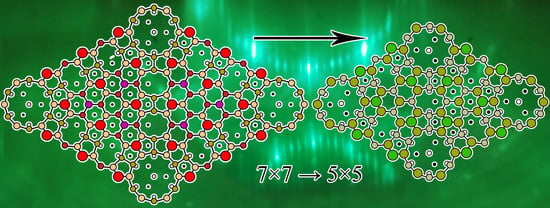Peculiarities of the 7 × 7 to 5 × 5 Superstructure Transition during Epitaxial Growth of Germanium on Silicon (111) Surface
Abstract
1. Background
2. Experimental Details
3. Results and Discussion
4. Conclusions
Author Contributions
Funding
Institutional Review Board Statement
Informed Consent Statement
Data Availability Statement
Acknowledgments
Conflicts of Interest
References
- Lawrie, W.I.L.; Eenink, H.G.J.; Hendrickx, N.W.; Boter, J.M.; Petit, L.; Amitonov, S.V.; Lodari, M.; Paquelet Wuetz, B.; Volk, C.; Philips, S.G.J.; et al. Veldhorst Quantum dot arrays in silicon and germanium. Appl. Phys. Lett. 2020, 116, 080501. [Google Scholar] [CrossRef]
- Izhnin, I.I.; Fitsych, O.I.; Voitsekhovskii, A.V.; Kokhanenko, A.P.; Lozovoy, K.A.; Dirko, V.V. Nanostructures with Ge–Si quantum dots for infrared photodetectors. Opto-Electron. Rev. 2018, 26, 195–200. [Google Scholar] [CrossRef]
- Wu, J.; Chen, S.; Seeds, A.; Liu, H. Quantum dot optoelectronic devices: Lasers, photodetectors and solar cells. J. Phys. D: Appl. Phys. 2015, 48, 363001. [Google Scholar] [CrossRef]
- Hendrickx, N.W.; Franke, D.P.; Sammak, A.; Kouwenhoven, M.; Sabbagh, D.; Yeoh, L.; Li, R.; Tagliaferri, M.L.V.; Virgilio, M.; Capellini, G.; et al. Gate-controlled quantum dots and superconductivity in planar germanium. Nat. Commun. 2018, 9, 2835. [Google Scholar] [CrossRef] [PubMed]
- Izhnin, I.I.; Kurbanov, K.R.; Lozovoy, K.A.; Kokhanenko, A.P.; Dirko, V.V.; Voitsekhovskii, A.V. Epitaxial fabrication of 2D materials of group IV elements. Appl. Nanosci. 2020, 10, 4375–4383. [Google Scholar] [CrossRef]
- Schröter, M.; Rosenbaum, T.; Chevalier, P.; Heinemann, B.; Voinigescu, S.P.; Preisler, E.; Böck, J.; Mukherjee, A. SiGe HBT technology: Future trends and TCAD-based. Proc. IEEE. 2017, 105, 1068–1086. [Google Scholar] [CrossRef]
- Lozovoy, K.A.; Izhnin, I.I.; Kokhanenko, A.P.; Dirko, V.V.; Vinarskiy, V.P.; Voitsekhovskii, A.V.; Fitsych, O.I.; Akimenko, N.Y. Single-element 2D materials beyond graphene: Methods of epitaxial synthesis. Nanomaterials 2022, 12, 2221. [Google Scholar] [CrossRef] [PubMed]
- Bukharaev, A.A.; Zvezdin, A.K.; Pyatakov, A.P.; Fetisov, Y.K. Straintronics: A new trend in micro- and nanoelectronics and materials science. Physics 2018, 61, 1175–1212. [Google Scholar] [CrossRef]
- Assali, S.; Albani, M.; Bergamaschini, R.; Verheijen, M.A.; Li, A.; Kölling, S.; Gagliano, L.; Bakkers, E.P.; Miglio, L. Strain engineering in Ge/GeSn core/shell nanowires. Appl. Phys. Lett. 2019, 115, 113102. [Google Scholar] [CrossRef]
- Timofeev, V.A.; Nikiforov, A.I.; Tuktamyshev, A.R.; Mashanov, V.I.; Loshkarev, I.D.; Bloshkin, A.A.; Gutakovskii, A.K. Pseudomorphic GeSiSn, SiSn and Ge layers in strained heterostructures. Semicond. Sci. Technol. 2018, 29, 154002. [Google Scholar] [CrossRef]
- Voigtlander, B. Fundamental processes in Si/Si and Ge/Si epitaxy studied by scanning tunneling microscopy during growth. Surf. Sci. Rep. 2001, 43, 127–254. [Google Scholar] [CrossRef]
- Aqua, J.N.; Berbezier, I.; Favre, L.; Frisch, T.; Ronda, A. Growth and self-organization of SiGe nanostructures. Phys. Rep. 2013, 522, 59–189. [Google Scholar] [CrossRef]
- Ichimiya, A.; Cohen, P.I.; Cohen, P.I. Reflection High-Energy Electron Diffraction; Cambridge University Press: Cambridge, UK, 2004; 349p. [Google Scholar]
- Berrie, C.L.; Leone, S.R. Observation of monolayer and bilayer period RHEED oscillations during epitaxial growth of Ge on Ge (1 0 0). J. Cryst. Growth 2000, 216, 159–170. [Google Scholar] [CrossRef]
- Fukutani, K.; Daimon, H.D.H.; Ino, S.I.S. Reflection high-energy electron diffraction study of the growth of Ge on the Ge(111). Jpn. J. Appl. Phys. 1992, 31, 3429–3435. [Google Scholar] [CrossRef]
- Lozovoy, K.A.; Korotaev, A.G.; Kokhanenko, A.P.; Dirko, V.V.; Voitsekhovskii, A.V. Kinetics of epitaxial formation of nanostructures by Frank–van der Merwe, Volmer–Weber and Stranski–Krastanow growth modes. Surf. Coat. Technol. 2020, 384, 125289. [Google Scholar] [CrossRef]
- Nikiforov, A.I.; Timofeev, V.A.; Teys, S.A.; Gutakovsky, A.K.; Pchelyakov, O.P. Initial stage growth of GexSi1-x layers and Ge quantum dot formation on GexSi1-x surface by MBE. Nanoscale Res. Lett. 2012, 7, 561. [Google Scholar] [CrossRef] [PubMed]
- Storozhevykh, M.S.; Arapkina, L.V.; Yuryev, V.A. Evidence for kinetic limitations as a controlling factor of Ge pyramid formation: A study of structural features of Ge/Si(001) wetting layer formed by Ge deposition at room temperature followed by annealing at 600 °C. Nanoscale Res. Lett. 2015, 10, 295. [Google Scholar] [CrossRef][Green Version]
- Talochkin, A.B.; Shklyaev, A.A.; Mashanov, V.I. Super-dense array of Ge quantum dots grown on Si(100) by low-temperature molecular beam epitaxy. J. Appl. Phys. 2014, 115, 144306. [Google Scholar] [CrossRef]
- Zhang, J.J.; Rastelli, A.; Schmidt, O.G.; Scopece, D.; Miglio, L.; Montalenti, F. Montalenti Self-organized evolution of Ge/Si(001) into intersecting bundles of horizontal nanowires during annealing. Appl. Phys. Lett. 2013, 103, 083109. [Google Scholar]
- Teys, S.A.; Talochkin, A.B.; Olshanetsky, B.Z. Formation of Ge nanoislands before the completion of a wetting layer in the Ge/Si(111) system. J. Cryst. Growth 2009, 311, 3898–3903. [Google Scholar] [CrossRef]
- Lozovoy, K.A.; Kokhanenko, A.P.; Dirko, V.V.; Akimenko, N.Y.; Voitsekhovskii, A.V. Evolution of epitaxial quantum dots formed by Volmer−Weber growth mechanism. Cryst. Growth Des. 2019, 19, 7015–7021. [Google Scholar] [CrossRef]
- Lozovoy, K.A.; Zhou, Y.; Smith, R.; Lloyd, A.; Kokhanenko, A.P.; Dirko, V.V.; Akimenko, N.Y.; Grigoryev, D.V.; Voitsekhovskii, A.V. Thickness-dependent surface energy and formation of epitaxial quantum dots. Thin Solid Film. 2020, 713, 138363. [Google Scholar] [CrossRef]
- Dirko, V.V.; Lozovoy, K.A.; Kokhanenko, A.P.; Voitsekhovskii, A.V. Thickness-dependent elastic strain in Stranski–Krastanow growth. Phys. Chem. Chem. Phys. 2020, 22, 19318–19325. [Google Scholar] [CrossRef]
- Dirko, V.V.; Lozovoy, K.A.; Kokhanenko, A.P.; Voitsekhovskii, A.V. High-resolution RHEED analysis of dynamics of low-temperature superstructure transitions in Ge/Si(001) epitaxial system. Nanotechnology 2022, 33, 115603. [Google Scholar] [CrossRef] [PubMed]
- Takayanagi, K.; Tanishiro, Y.; Takahashi, S.; Takahashi, M. Structure analysis of Si(111)-7 × 7 reconstructed surface by transmission electron diffraction. Surf. Sci. 1985, 164, 367–392. [Google Scholar] [CrossRef]
- Shklyaev, A.A.; Shibata, M.; Ichikawa, M. Ge islands on Si(111) at coverages near the transition from two-dimensional to three-dimensional growth. Surf. Sci. 1998, 416, 192–199. [Google Scholar] [CrossRef]
- Grimm, A.; Fissel, A.; Bugiel, E.; Wietler, T.F. In situ observation of low temperature growth of Ge on Si(111) by reflection high energy electron diffraction. Appl. Surf. Sci. 2016, 370, 40–48. [Google Scholar] [CrossRef]
- Filimonov, S.; Cherepanov, V.; Hervieu, Y.; Voigtlander, B. Multistage nucleation of two-dimensional Si islands on Si(111)-7 × 7 during MBE growth: STM experiments and extended rate-equation model. Phys. Rev. B 2007, 76, 035428. [Google Scholar] [CrossRef]
- Paul, N.; Filimonov, S.; Cherepanov, V.; Cakmak, M.; Voightlander, B. Identification of Ge/Si intermixing processes at the Bi/Ge/Si(111) surface. Phys. Rev. Lett. 2007, 98, 166104. [Google Scholar] [CrossRef]
- Teys, S.A. Different growth mechanisms of Ge by Stranski–Krastanow on Si (111) and (001) surfaces: An STM study. Appl. Surf. Sci. 2017, 392, 1017–1025. [Google Scholar] [CrossRef]
- Lozovoy, K.; Kokhanenko, A.; Voitsekhovskii, A. Comparative analysis of germanium-silicon quantum dots formation on Si(100), Si(111) and Sn/Si(100) surfaces. Nanotechnology 2018, 29, 054002. [Google Scholar] [CrossRef] [PubMed]
- MacLeod, J.M.; Psiachos, D.; Stott, M.J.; McLean, A.B. Indium clusters on the Ge (5 × 5) wetting layer of Si(111)–7 × 7. Phys. Rev. J. B 2006, 73, 241306. [Google Scholar] [CrossRef]
- Yoshida, R.; Tosaka, A.; Shigeta, Y. Surface morphology and structure of Ge layer on Si(111) after solid phase epitaxy. Surf. Sci. 2018, 671, 43–50. [Google Scholar] [CrossRef]
- Rogilo, D.I.; Fedina, L.I.; Kosolobov, S.S.; Latyshev, A.V. On the role of mobile nanoclusters in 2D island nucleation on Si(111)-(7 × 7) surface. Surf. Sci. 2018, 667, 1–7. [Google Scholar] [CrossRef]
- Zhachuk, R.; Teys, S.; Coutinho, J. Strain-induced structure transformations on Si(111) and Ge(111) surfaces: A combined density-functional and scanning tunneling microscopy study. J. Chem. Phys. 2013, 138, 224702. [Google Scholar] [CrossRef]
- Maeda, T.; Jevasuwan, W.; Hattori, H.; Uchida, N.; Miura, S.; Tanaka, M.; Santos, N.D.M.; Vantomme, A.; Locquet, J.-P.; Lieten, R.R. Ultrathin GeSn p-channel MOSFETs grown directly on Si(111) substrate using solid phase epitaxy. Jpn. J. Appl. Phys. 2015, 54, 04DA07. [Google Scholar] [CrossRef]
- Han, G.; Wang, Y.; Liu, Y.; Zhang, C.; Feng, Q.; Liu, M.; Zhao, S.; Cheng, B.; Zhang, J.; Hao, Y. GeSn quantum well p-channel tunneling FETs Fabricated on Si(001) and (111) With Improved Subthreshold Swing. IEEE Electron Device Lett. 2016, 37, 701–704. [Google Scholar] [CrossRef]
- Pokharia, R.S.; Khiangte, K.R.; Rathore, J.S.; Schmidt, J.; Osten, H.J.; Laha, A.; Mahapatra, S. Metal semiconductor metal photodiodes based on all-epitaxial Ge-on-insulator-on- Si(111), grown by molecular beam epitaxy. In SPIE Proceedings: Optical Components and Materials XVI; SPIE: Bellingham, WA, USA, 2019; Volume 10914, p. 1091417. [Google Scholar]
- Shklyaev, A.; Bolotov, L.; Poborchii, V.; Tada, T. Properties of three-dimensional structures prepared by Ge dewetting from Si(111) at high temperatures. J. Appl. Phys. 2015, 117, 205303. [Google Scholar] [CrossRef]
- Alam, M.M.; Hoshi, Y.; Sawano, K. Structural properties of compressive strained Ge channels fabricated on Si (111) and Si (100). Semicond. Sci. Technol. 2018, 33, 124008. [Google Scholar] [CrossRef]
- Benediktovich, A.; Zhylik, A.; Ulyanenkova, T.; Myronov, M.; Ulyanenkov, A. Characterization of dislocations in germanium layers grown on (011)- and (111)-oriented silicon by coplanar and noncoplanar X-ray diffraction. J. Appl. Crystallogr. 2015, 48, 655–665. [Google Scholar] [CrossRef]
- Xu, S.; Li, Y.; Chen, Y. Si/Ge (111) Semicoherent Interfaces: Responses to an In-Plane Shear and Interactions with Lattice Dislocations. Phys. Status Solidi B 2020, 257, 2000274. [Google Scholar] [CrossRef]
- Miao, Y.-H.; Hu, H.-Y.; Song, J.-J.; Xuan, R.-X.; Zhang, H.-M. Effects of rapid thermal annealing on crystallinity and Sn surface segregation of Ge1-𝑥Sn𝑥 films on Si (100) and Si (111). Chin. Phys. B 2017, 26, 127306. [Google Scholar] [CrossRef]
- Wang, L.; Zhang, Y.; Sun, H.; You, J.; Miao, Y.; Dong, Z.; Liu, T.; Jiang, Z.; Hu, H. Nanoscale growth of a Sn-guided SiGeSn alloy on Si (111) substrates by molecular beam epitaxy. Nanoscale Adv. 2021, 3, 997. [Google Scholar] [CrossRef] [PubMed]
- Mamiyev, Z.; Pfnur, H. View on Si(111)-(5 × 2)-Au with plasmon spectroscopy. Phys. Rev. B 2020, 102, 075438. [Google Scholar] [CrossRef]
- Olyanich, D.A.; Utas, T.V.; Bondarenko, L.V.; Tupchaya, A.Y.; Gruznev, D.V.; Mihalyuk, A.N.; Zotov, A.V.; Saranin, A.A. Structural and electronic effects of adsorbed Bi on the metallic atomic chains in Au/Si(111)5 × 2. Appl. Surf. Sci. 2021, 558, 149859. [Google Scholar] [CrossRef]
- Tao, M.-L.; Tu, Y.-B.; Sun, K.; Wang, Y.-L.; Xie, Z.-B.; Liu, L.; Shi, M.-X.; Wang, J.-Z. Gallenene epitaxially grown on Si(1 1 1). 2D Mater. 2018, 5, 035009. [Google Scholar] [CrossRef]
- Charles, M.; Kanyandekwe, J.; Bos, S.; Baines, Y.; Morvan, E.; Torres, A.; Templier, F.; Plissonnier, M. Epitaxy of GaN on Si (111) for Power Electronics, RF and LEDs. ECS Trans. 2018, 86, 233–247. [Google Scholar] [CrossRef]
- Bansal, A.; Martin, N.C.; Wang, K.; Redwing, J.M. GaN Heteroepitaxy on Strain-Engineered (111) Si/Si1-xGex. J. Electron. Mater. 2019, 48, 3355–3362. [Google Scholar] [CrossRef]
- Monzur-Ul-Akhir, A.A.M.; Mori, M.; Maezawa, K. An investigation of the crystalline nature for GaSb films on Si(111) at varied growth temperature and growth rate. Jpn. J. Appl. Phys. 2019, 58, SII17. [Google Scholar] [CrossRef]
- Zhu, F.; Chen, W.; Xu, Y.; Gao, C.-L.; Guan, D.-D.; Liu, C.-H.; Qian, D.; Zhang, S.-C.; Jia, J.-F. Epitaxial growth of two-dimensional stanene. Nat. Mater. 2015, 14, 1020–1025. [Google Scholar] [CrossRef]
- Qin, J.; Qiu, G.; Jian, J.; Zhou, H.; Yang, L.; Charnas, A.; Zemlyanov, D.Y.; Xu, C.-Y.; Xu, X.; Wu, W.; et al. Controlled Growth of a Large-Size 2D Selenium Nanosheet and Its Electronic and Optoelectronic Applications. ACS Nano 2017, 11, 10222–10229. [Google Scholar] [CrossRef] [PubMed]
- Nakamura, T.; Takayama, A.; Hobara, R.; Gruznev, D.V.; Zotov, A.V.; Saranin, A.A.; Hasegawa, S. Superconducting single-atomic-layer Tl-Pb compounds on Ge(111) and Si (111) surfaces. Appl. Surf. Sci. 2019, 479, 679–684. [Google Scholar] [CrossRef]
- Gruznev, D.V.; Bondarenko, L.V.; Tupchaya, A.Y.; Mihalyuk, A.N.; Eremeev, S.V.; Zotov, A.V.; Saranin, A.A. Thallene: Graphene-like honeycomb lattice of Tl atoms frozen on single-layer NiSi2. 2D Mater. 2020, 7, 045026. [Google Scholar] [CrossRef]
- Mihalyuk, A.N.; Vekovshinin, Y.E.; Bondarenko, L.V.; Tupchaya, A.Y.; Utas, T.V.; Gruznev, D.V.; Eremeev, S.V.; Zotov, A.V.; Saranin, A.A. Insights Into the Electronic Properties of PbBi Atomic Layers on Ge(111) and Si(111) Surfaces. Front. Mater. 2022, 9, 882008. [Google Scholar] [CrossRef]
- Lozovoy, K.A.; Dirko, V.V.; Vinarskiy, V.P.; Kokhanenko, A.P.; Voitsekhovskii, A.V.; Akimenko, N.Y. Two-dimensional materials of group IVA: Latest advances in epitaxial methods of growth. Russ. Phys. J. 2022, 64, 1583–1591. [Google Scholar] [CrossRef]
- Ponomarenko, V.P.; Popov, V.S.; Popov, S.V.; Chepurnov, E.L. Photo- and Nanoelectronics Based on Two-Dimensional Materials. Part I. Two-Dimensional Materials: Properties and Synthesis. J. Commun. Technol. Electron. 2020, 65, 1062–1104. [Google Scholar] [CrossRef]
- Isa, F.; Pezzoli, F.; Isella, G.; Meduna, M.; Falub, C.V.; Muller, E.; Kreiliger, T.; Taboada, A.G.; von Kanel, H.; Miglio, L. Three-dimensional Ge/SiGe multiple quantum wells deposited on Si(001) and Si (111) patterned substrates. Semicond. Sci. Technol. 2015, 30, 105001. [Google Scholar] [CrossRef]
- Genath, H.; Norberg, J.; Wolpensinger, B.; Osten, H.J. Investigation of the temperature stability of germanium-rich SiGe layers on Si(111) substrates. Thin Solid Film. 2022, 763, 139561. [Google Scholar] [CrossRef]
- Ichikawa, T.; Ino, S. Rheed study on the Ge/Si(111) and Si/Ge(111) systems: Reaction of Ge with the Si(111)(7 × 7) surface. Surf. Sci. 1984, 136, 267–284. [Google Scholar] [CrossRef]
- Ishii, C.; Shigeta, Y. Structural changes due to reannealing of Ge thin films prepared by solid phase epitaxial growth on Si (111) surface. Thin Solid Film. 2020, 709, 138007. [Google Scholar] [CrossRef]
- Vinarskiy, V.P.; Kokhanenko, A.P.; Lozovoy, K.A. Modelling of epitaxial growth of two-dimensional film. J. Phys. Conf. Ser. 2021, 2140, 012001. [Google Scholar] [CrossRef]
- Zhou, Y.; Lloyd, A.; Smith, R.; Lozovoy, K.A.; Voitsekhovskii, A.V.; Kokhanenko, A.P. Molecular dynamics simulations of the growth of Ge on Si. Surf. Sci. 2020, 696, 121594. [Google Scholar] [CrossRef]
- Kashammer, P.; Borgardt, N.I.; Seibt, M.; Sinno, T. Quantitative assessment of molecular dynamics-grown amorphous silicon and germanium films on silicon (111). Surf. Sci. 2016, 651, 100–104. [Google Scholar] [CrossRef]
- Izhnin, I.I.; Lozovoy, K.A.; Kokhanenko, A.P.; Khomyakova, K.I.; Douhan, R.M.H.; Dirko, V.V.; Voitsekhovskii, A.V.; Fitsych, O.I.; Akimenko, N.Y. Single-photon avalanche diode detectors based on group IV materials. Appl. Nanosci. 2022, 12, 253–263. [Google Scholar] [CrossRef]


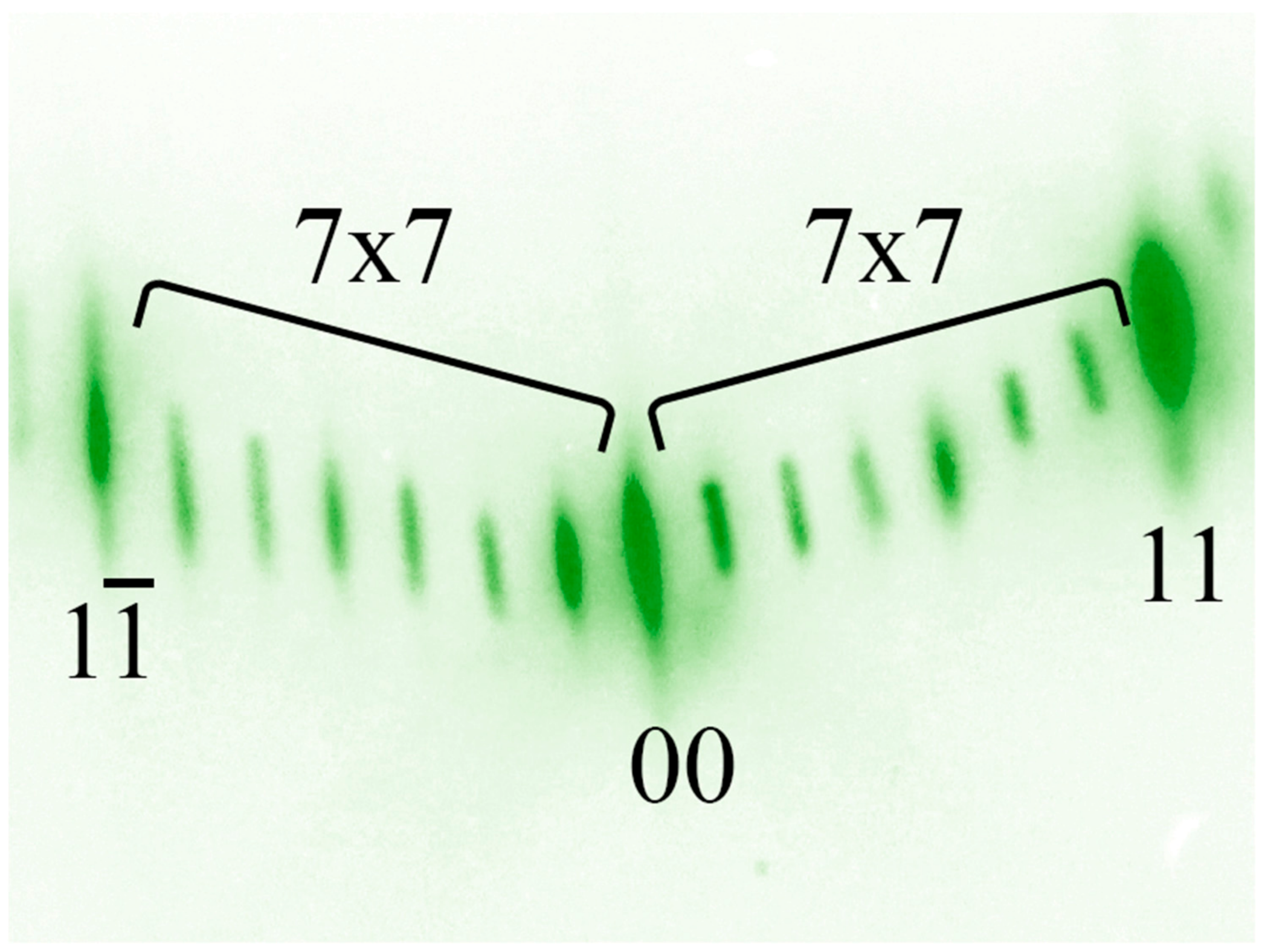

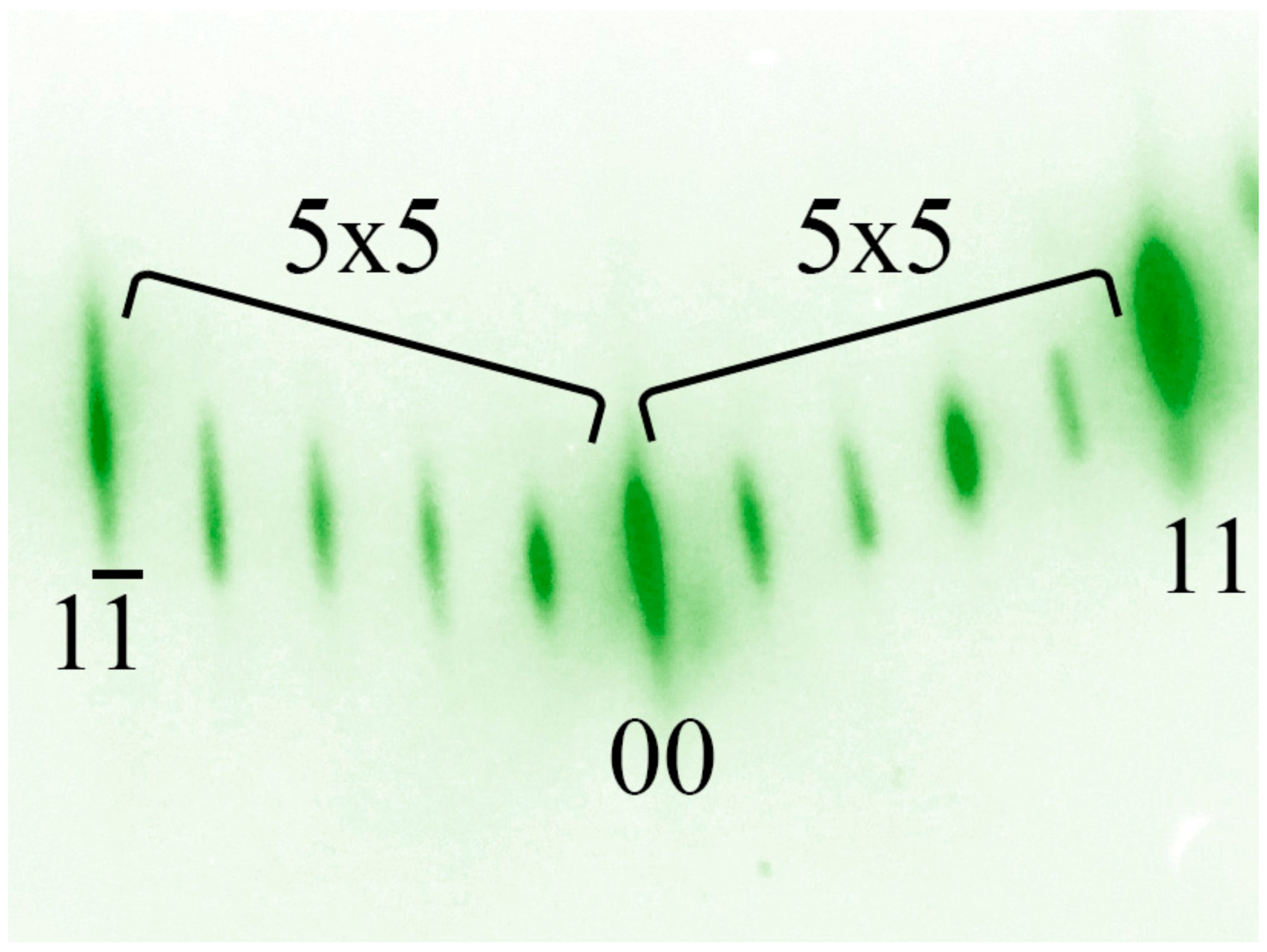
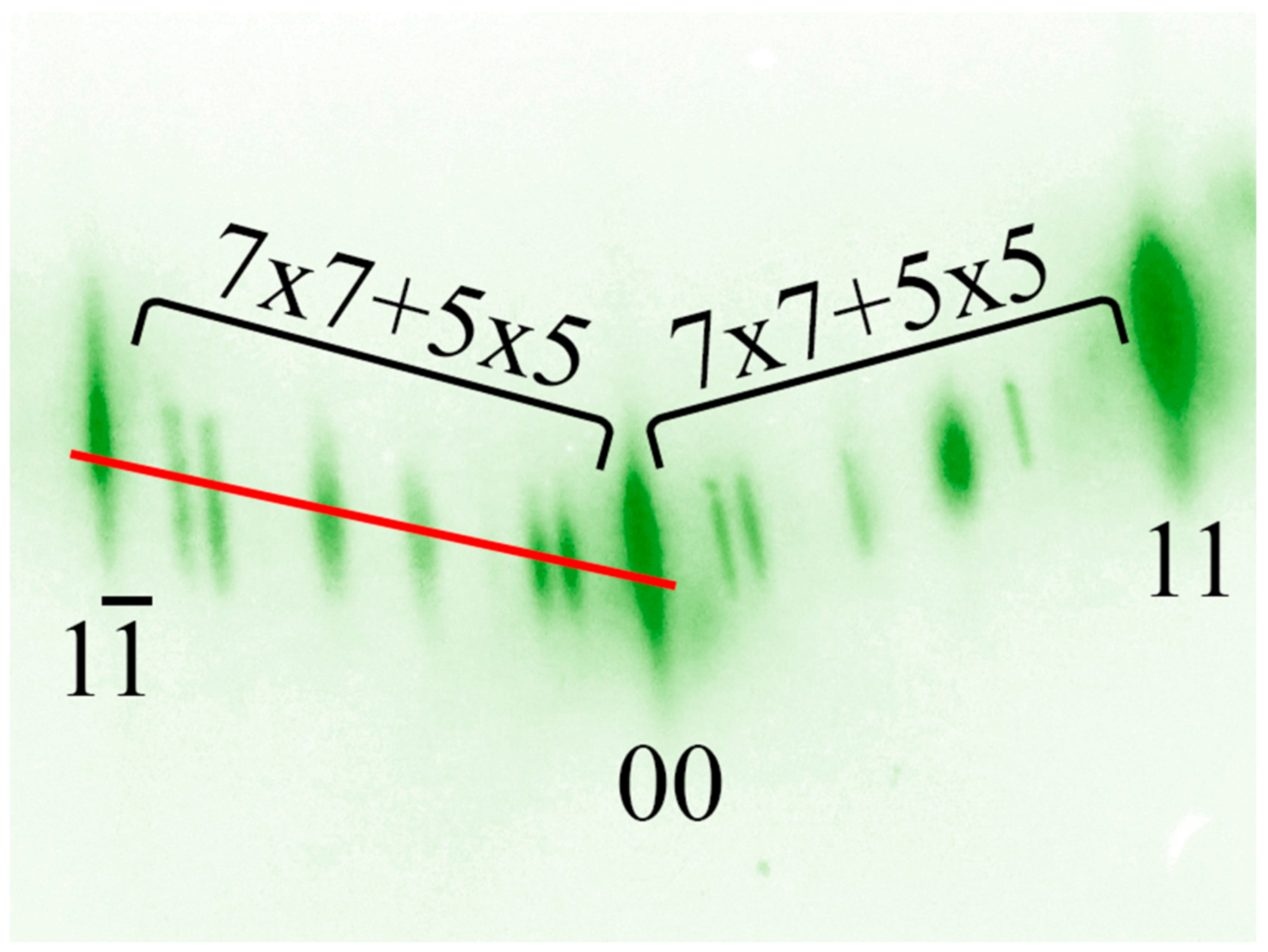

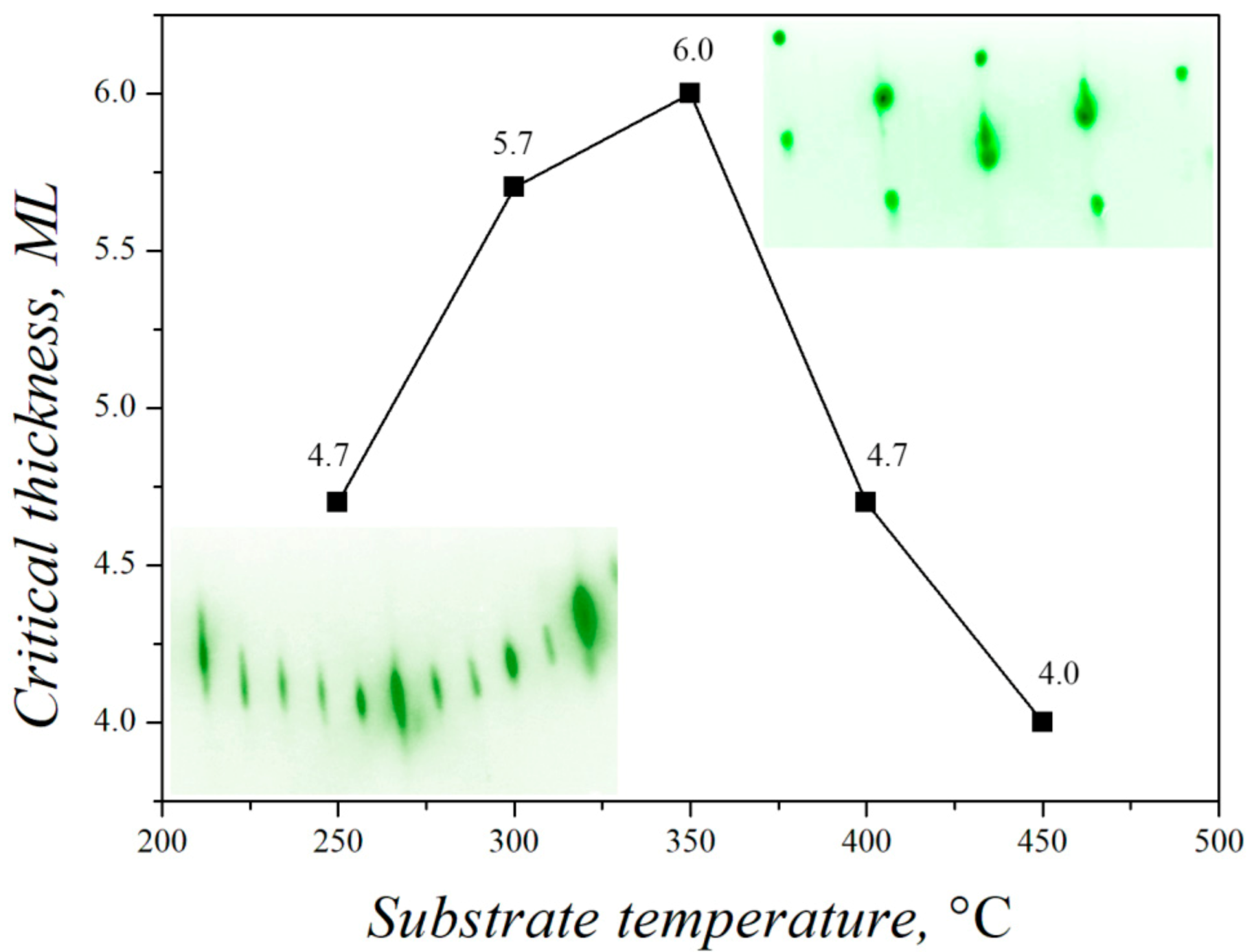
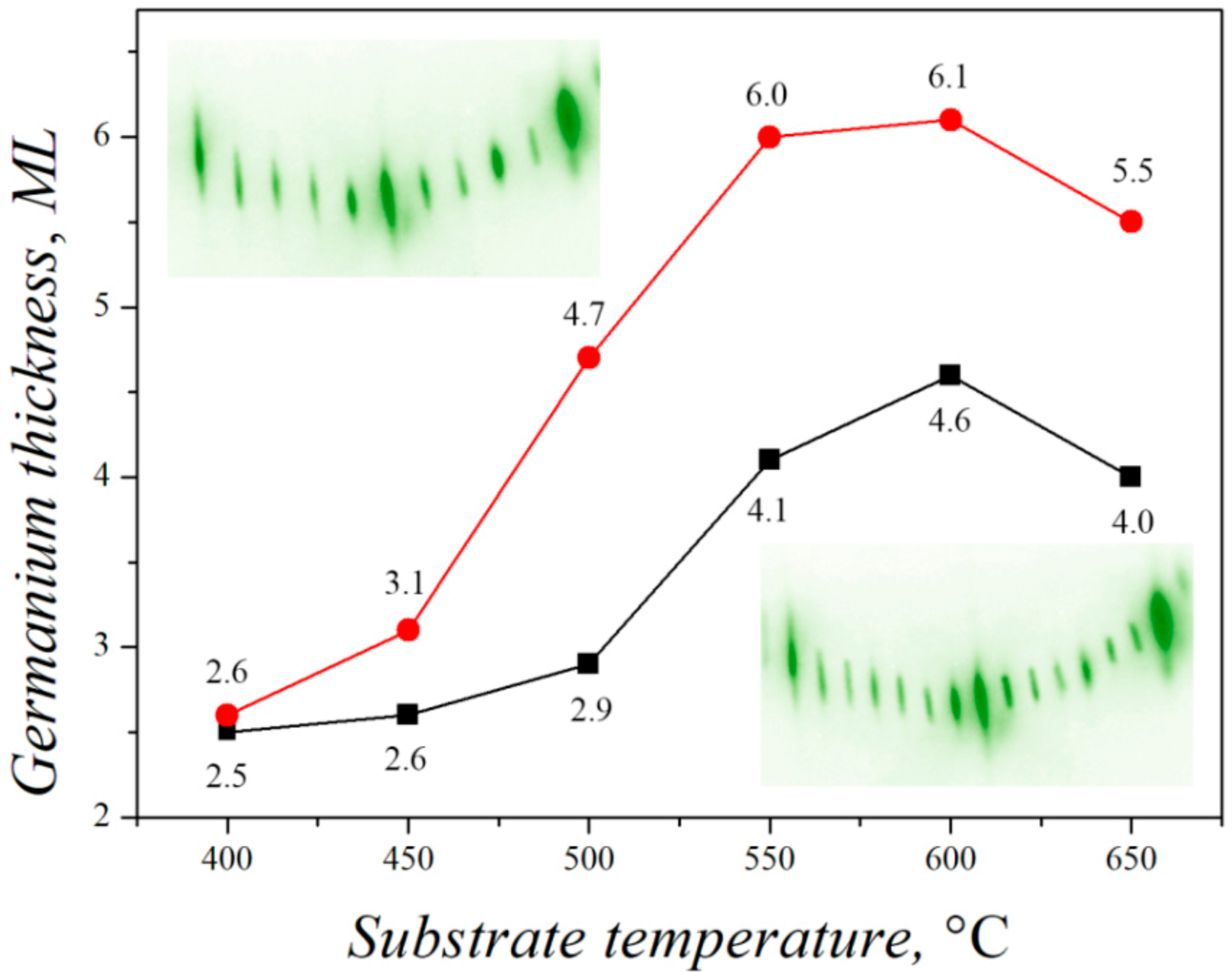
Disclaimer/Publisher’s Note: The statements, opinions and data contained in all publications are solely those of the individual author(s) and contributor(s) and not of MDPI and/or the editor(s). MDPI and/or the editor(s) disclaim responsibility for any injury to people or property resulting from any ideas, methods, instructions or products referred to in the content. |
© 2023 by the authors. Licensee MDPI, Basel, Switzerland. This article is an open access article distributed under the terms and conditions of the Creative Commons Attribution (CC BY) license (https://creativecommons.org/licenses/by/4.0/).
Share and Cite
Dirko, V.V.; Lozovoy, K.A.; Kokhanenko, A.P.; Kukenov, O.I.; Korotaev, A.G.; Voitsekhovskii, A.V. Peculiarities of the 7 × 7 to 5 × 5 Superstructure Transition during Epitaxial Growth of Germanium on Silicon (111) Surface. Nanomaterials 2023, 13, 231. https://doi.org/10.3390/nano13020231
Dirko VV, Lozovoy KA, Kokhanenko AP, Kukenov OI, Korotaev AG, Voitsekhovskii AV. Peculiarities of the 7 × 7 to 5 × 5 Superstructure Transition during Epitaxial Growth of Germanium on Silicon (111) Surface. Nanomaterials. 2023; 13(2):231. https://doi.org/10.3390/nano13020231
Chicago/Turabian StyleDirko, Vladimir V., Kirill A. Lozovoy, Andrey P. Kokhanenko, Olzhas I. Kukenov, Alexander G. Korotaev, and Alexander V. Voitsekhovskii. 2023. "Peculiarities of the 7 × 7 to 5 × 5 Superstructure Transition during Epitaxial Growth of Germanium on Silicon (111) Surface" Nanomaterials 13, no. 2: 231. https://doi.org/10.3390/nano13020231
APA StyleDirko, V. V., Lozovoy, K. A., Kokhanenko, A. P., Kukenov, O. I., Korotaev, A. G., & Voitsekhovskii, A. V. (2023). Peculiarities of the 7 × 7 to 5 × 5 Superstructure Transition during Epitaxial Growth of Germanium on Silicon (111) Surface. Nanomaterials, 13(2), 231. https://doi.org/10.3390/nano13020231




